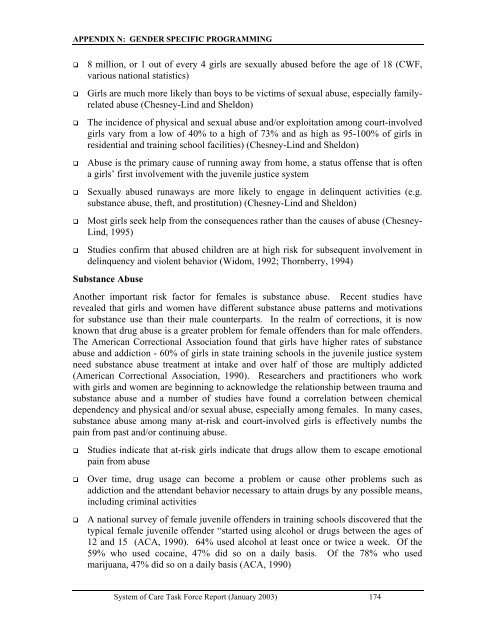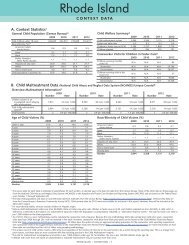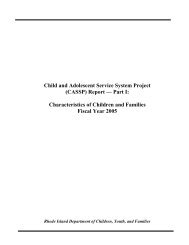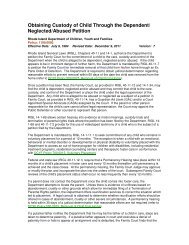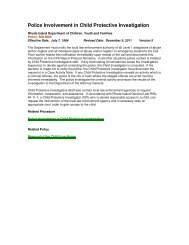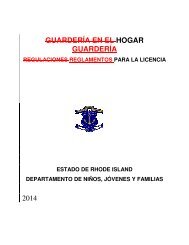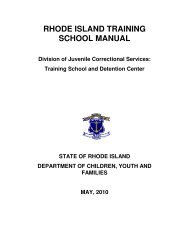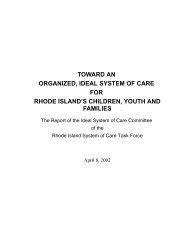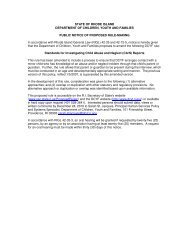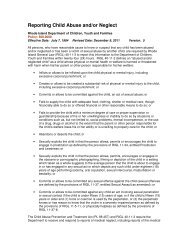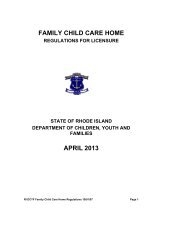Final Report - RI Department of Children, Youth & Families
Final Report - RI Department of Children, Youth & Families
Final Report - RI Department of Children, Youth & Families
You also want an ePaper? Increase the reach of your titles
YUMPU automatically turns print PDFs into web optimized ePapers that Google loves.
APPENDIX N: GENDER SPECIFIC PROGRAMMING<br />
! 8 million, or 1 out <strong>of</strong> every 4 girls are sexually abused before the age <strong>of</strong> 18 (CWF,<br />
various national statistics)<br />
! Girls are much more likely than boys to be victims <strong>of</strong> sexual abuse, especially familyrelated<br />
abuse (Chesney-Lind and Sheldon)<br />
! The incidence <strong>of</strong> physical and sexual abuse and/or exploitation among court-involved<br />
girls vary from a low <strong>of</strong> 40% to a high <strong>of</strong> 73% and as high as 95-100% <strong>of</strong> girls in<br />
residential and training school facilities) (Chesney-Lind and Sheldon)<br />
! Abuse is the primary cause <strong>of</strong> running away from home, a status <strong>of</strong>fense that is <strong>of</strong>ten<br />
a girls’ first involvement with the juvenile justice system<br />
! Sexually abused runaways are more likely to engage in delinquent activities (e.g.<br />
substance abuse, theft, and prostitution) (Chesney-Lind and Sheldon)<br />
! Most girls seek help from the consequences rather than the causes <strong>of</strong> abuse (Chesney-<br />
Lind, 1995)<br />
! Studies confirm that abused children are at high risk for subsequent involvement in<br />
delinquency and violent behavior (Widom, 1992; Thornberry, 1994)<br />
Substance Abuse<br />
Another important risk factor for females is substance abuse. Recent studies have<br />
revealed that girls and women have different substance abuse patterns and motivations<br />
for substance use than their male counterparts. In the realm <strong>of</strong> corrections, it is now<br />
known that drug abuse is a greater problem for female <strong>of</strong>fenders than for male <strong>of</strong>fenders.<br />
The American Correctional Association found that girls have higher rates <strong>of</strong> substance<br />
abuse and addiction - 60% <strong>of</strong> girls in state training schools in the juvenile justice system<br />
need substance abuse treatment at intake and over half <strong>of</strong> those are multiply addicted<br />
(American Correctional Association, 1990). Researchers and practitioners who work<br />
with girls and women are beginning to acknowledge the relationship between trauma and<br />
substance abuse and a number <strong>of</strong> studies have found a correlation between chemical<br />
dependency and physical and/or sexual abuse, especially among females. In many cases,<br />
substance abuse among many at-risk and court-involved girls is effectively numbs the<br />
pain from past and/or continuing abuse.<br />
! Studies indicate that at-risk girls indicate that drugs allow them to escape emotional<br />
pain from abuse<br />
! Over time, drug usage can become a problem or cause other problems such as<br />
addiction and the attendant behavior necessary to attain drugs by any possible means,<br />
including criminal activities<br />
! A national survey <strong>of</strong> female juvenile <strong>of</strong>fenders in training schools discovered that the<br />
typical female juvenile <strong>of</strong>fender “started using alcohol or drugs between the ages <strong>of</strong><br />
12 and 15 (ACA, 1990). 64% used alcohol at least once or twice a week. Of the<br />
59% who used cocaine, 47% did so on a daily basis. Of the 78% who used<br />
marijuana, 47% did so on a daily basis (ACA, 1990)<br />
System <strong>of</strong> Care Task Force <strong>Report</strong> (January 2003) 174


